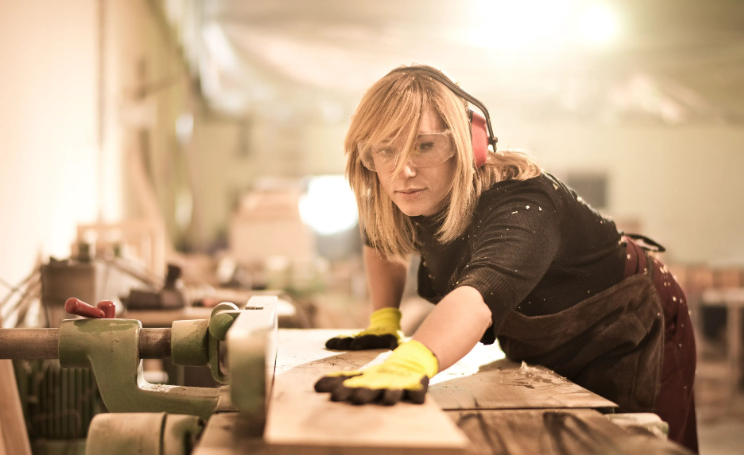Whether you are a DIY or a professional, safety is paramount
The construction industry involves a wide range of hazards, including falls from heights, electrical hazards, flying debris, and exposure to harmful substances. As a result, workers in this industry require a variety of safety gear to protect themselves from these hazards. Some important safety gear for the construction industry include:
- Hard hats: These protect the head from falling objects, bumps, and electrical hazards.
- Safety glasses and goggles: These protect the eyes from flying debris, dust, and other hazards.
- Respirators: These protect the lungs from harmful dust, fumes, and other airborne particles.
- Hearing protection: This includes earplugs or earmuffs, which protect the ears from loud noises.
- Safety shoes or boots: These protect the feet from falling objects, punctures, and other hazards.
- High visibility clothing: This makes workers more visible to others on the job site, reducing the risk of accidents.
- Gloves: These protect the hands from cuts, abrasions, and exposure to harmful substances.
- Fall protection equipment: This includes harnesses, lanyards, and anchors, which protect workers from falls from heights.
- Fire-resistant clothing: This protects workers from flames, heat, and other fire hazards.
- Protective clothing: This includes clothing made of materials that resist chemicals, heat, and other hazards.

It is important for workers to wear the appropriate safety gear for their job tasks and to ensure that the gear is in good condition before using it. Proper training and supervision can also help prevent accidents and ensure that workers use safety gear correctly.
There is no specific law or regulation in Ontario, Canada that prohibits wearing shorts on a construction site. However, the Occupational Health and Safety Act (OHSA) requires that employers take every reasonable precaution to protect the health and safety of workers on construction sites.
Employers are responsible for assessing the hazards associated with each job task and ensuring that workers are provided with appropriate personal protective equipment (PPE) to protect them from those hazards. Depending on the type of construction work being performed, wearing shorts may not be appropriate or safe. For example, workers performing tasks that involve hot surfaces, welding, or handling chemicals may need to wear pants made of fire-resistant or chemical-resistant material to protect their skin.
In general, employers are encouraged to develop and enforce a dress code policy that takes into consideration the hazards present in their particular workplace. This policy should clearly communicate the PPE requirements for each job task and ensure that workers are provided with appropriate PPE, including clothing that is comfortable, durable, and appropriate for the job. Ultimately, the goal should be to ensure that workers are protected from hazards and able to perform their job tasks safely.

Importance of Fire Safety in Construction and DIY Renovation
Fire safety is of utmost importance in any construction environment or DIY renovation scenario. Fires can cause significant damage to property, pose serious risks to human life, and result in financial loss. By prioritizing fire safety measures, individuals can protect themselves, their property, and others from the devastating consequences of a fire. Here are several key reasons why fire safety is crucial in construction and DIY renovation:
- Protecting Lives: The safety and well-being of individuals involved in construction or DIY projects should always be the top priority. Fires can spread rapidly and create life-threatening situations. Implementing fire safety measures such as installing smoke detectors, fire extinguishers, and emergency evacuation plans can help ensure that everyone in the construction area or renovation site is alerted promptly and can safely exit the premises.
- Preventing Property Damage: Fires can cause extensive damage to structures, materials, and valuable possessions. Construction sites often have numerous flammable materials and tools that can fuel a fire. Adhering to fire safety practices, such as properly storing and handling flammable substances, using fire-resistant materials where appropriate, and implementing fire barriers and suppression systems, can greatly reduce the risk of fire-related property damage.
- Mitigating Financial Loss: Fires can result in substantial financial loss, including repair or reconstruction costs, replacement of damaged equipment or materials, and potential legal liabilities. Adequate fire safety measures can help minimize the financial impact of a fire by preventing or limiting the extent of damage. This is particularly important for construction businesses, homeowners, and DIY enthusiasts who have invested significant resources in their projects.
- Ensuring Compliance with Regulations: Construction and renovation projects are subject to various building codes, regulations, and fire safety standards. Failing to meet these requirements can lead to legal consequences, including fines and delays in project completion. By prioritizing fire safety measures and following the established regulations, individuals can ensure compliance and maintain a safe working environment.
- Minimizing Interruptions and Delays: Fires can cause significant disruptions and delays in construction or renovation projects. Rebuilding or repairing damaged structures, replacing equipment, and addressing safety concerns can result in substantial project setbacks. By implementing fire safety practices from the outset, individuals can minimize the likelihood of fire incidents and subsequent project interruptions.
- Promoting Environmental Stewardship: Fires not only pose risks to human life and property but can also harm the environment. The release of toxic smoke, chemicals, and pollutants during a fire can have detrimental effects on air and water quality. By implementing fire safety measures, individuals contribute to environmental stewardship by reducing the occurrence of fires and minimizing their environmental impact.
Conclusion: Fire safety should be a primary consideration in any construction environment or DIY renovation scenario. By prioritizing fire prevention, implementing safety measures, and adhering to regulations, individuals can protect lives, prevent property damage, mitigate financial loss, ensure compliance, minimize project interruptions, and promote environmental stewardship. Remember, investing in fire safety is a crucial responsibility that should never be overlooked in the construction and
DIY renovation process.